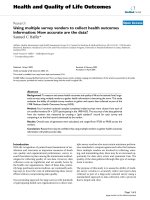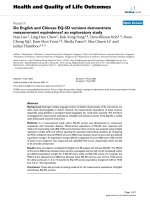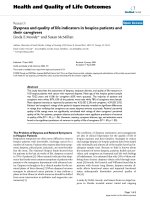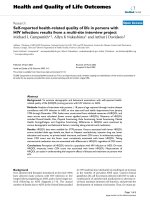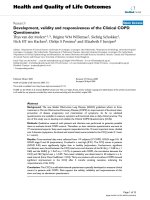Health and Quality of Life Outcomes BioMed Central Research Open Access Minimal Important potx
Bạn đang xem bản rút gọn của tài liệu. Xem và tải ngay bản đầy đủ của tài liệu tại đây (227.15 KB, 5 trang )
BioMed Central
Page 1 of 5
(page number not for citation purposes)
Health and Quality of Life Outcomes
Open Access
Research
Minimal Important Difference (MID) of the Dermatology Life
Quality Index (DLQI): Results from patients with chronic idiopathic
urticaria
Richard Shikiar*
1
, Gale Harding
2
, Michael Leahy
3
and Richard D Lennox
4
Address:
1
MEDTAP International, Inc., Seattle, WA, USA,
2
MEDTAP International, Inc., Bethesda, MD, USA,
3
Aventis Pharmaceuticals, Inc.,
Bridgewater, NJ, USA and
4
Psychometric Technologies, Inc., Hillsborough, NC, USA
Email: Richard Shikiar* - ; Gale Harding - ; Michael Leahy - ;
Richard D Lennox -
* Corresponding author
Abstract
Background: The Dermatology Quality Life Index (DLQI) has seen widespread use as a health-
related quality of life measure for a variety of dermatological diseases. The purpose of this study
was to estimate the minimal important difference (MID) on the DLQI for patients with chronic
idiopathic urticaria (CIU).
Methods: Data from 2 Phase III clinical trials of patients (N = 476 for Study A; N = 468 for Study
B) with CIU were analyzed separately to estimate the MID for the DLQI for these populations.
Both distributional based and anchor based approaches were used for deriving estimates. The
anchor based approach relied upon patient self assessments of pruritus severity; the distributional
based approaches relied upon estimating the standard error of measurement, as well as one-half
the standard deviation of the DLQI from each study.
Results: The distributional approaches resulted in estimates of MID ranging from 2.24 to 3.10 for
the two studies. The anchor based approach resulted in estimates of 3.21 and 2.97 for the two
studies.
Conclusion: An MID for the DLQI in the range of 2.24 to 3.10 is recommended in interpreting
results for patients with CIU.
Background
Skin disease has long been recognized as having an
adverse psychosocial impact on patients [1-3]. During the
past decade, the formal assessment of patient health-
related quality of life (HRQL) has been included in stud-
ies to assess the management of chronic skin disease and
evaluate new treatments. The Dermatology Life Quality
Index (DLQI), in particular, has been used in a number of
studies of dermatological diseases including eczema, pso-
riasis, and chronic idiopathic urticaria (CIU) to evaluate
the impact of treatment in these patient populations [4-
9]. The DLQI was originally developed as a brief question-
naire for routine clinical use to assess the limitations
related to the impact of skin disease and has been shown
to be responsive to clinical changes in a study of derma-
tology [9].
Published: 20 May 2005
Health and Quality of Life Outcomes 2005, 3:36 doi:10.1186/1477-7525-3-
36
Received: 01 March 2005
Accepted: 20 May 2005
This article is available from: />© 2005 Shikiar et al; licensee BioMed Central Ltd.
This is an Open Access article distributed under the terms of the Creative Commons Attribution License ( />),
which permits unrestricted use, distribution, and reproduction in any medium, provided the original work is properly cited.
Health and Quality of Life Outcomes 2005, 3:36 />Page 2 of 5
(page number not for citation purposes)
While the DLQI and other outcomes measures provide a
useful benchmark by which to evaluate the effectiveness
of treatment, there has been a growing interest among cli-
nicians and regulatory agencies, such as the U.S. Food and
Drug Administration, in identifying meaningful change in
HRQL. The concept of the minimal important difference
(MID) refers to the smallest difference in a score that is
considered to be worthwhile or important [10]. Juniper
and colleagues [11-13] define a minimal clinical impor-
tant difference as "the smallest difference in a
score which patients perceive as beneficial and which
would mandate, in the absence of troublesome side
effects and excessive cost, a change in the patient's man-
agement". For clinicians, it could be used as a threshold
by which they recommend a therapy to their patients.
The purpose of this study is to estimate a MID for the
DLQI in patients with CIU, a chronic skin condition
defined by recurrent pruritic welts or wheals.
Methods
Data for the analyses are based on two Phase III rand-
omized, double-blind, parallel group, placebo-controlled
multi-center clinical trials that were conducted to assess
the efficacy and safety of fexofenadine HCl in the treat-
ment of CIU. The two studies are labeled Studies A and B,
and were similar in design. Details of these studies are
reported elsewhere [5,6]. The primary objective of both
studies was to assess the clinical efficacy and safety of a
range of fexofenadine HCl doses (20, 60, 120, and 240 mg
bid) compared to placebo for the relief of CIU symptoms.
Both studies involved a 24-hour, single-blind placebo
lead-in, followed by a four-week, double-blind treatment
period. Each study included three site visits approximately
two weeks apart. A secondary objective was to assess
health-related quality of life (HRQL) among study sub-
jects using the DLQI. The analyses described in this report
do not evaluate treatment effects on HRQL. This report
focuses on examining the MID of the DLQI among
patients with CIU who participated in the two clinical
trials.
Subjects and inclusion criteria
Male and female subjects aged 12 to 65 years with a diag-
nosis of CIU, defined as the presence of urticarial wheals
for at least 3 days per week for six consecutive weeks, were
eligible to participate in these studies. In addition, sub-
jects had to have a minimum of one to five wheals with
moderate to severe itching during the previous 12 hours.
A total of 476 and 468 subjects participated in Studies A
and B respectively. Both studies recruited subjects from
multiple clinical sites in the U.S. and Canada.
Measures
Dermatology Life Quality Index (DLQI)
The DLQI was used to assess health-related quality of life
among study participants. Subjects were asked to com-
plete the DLQI at three scheduled study visits: baseline,
week 2, and week 4 (end of study). The DLQI is designed
to assess the impact of a wide range of skin disease on
patient health-related quality of life (HRQL) [9]. It con-
sists of ten items and covers six domains including symp-
toms and feelings, daily activities, leisure, work and
school, personal relationships, and treatment. Response
categories include "not at all," "a little," "a lot," and "very
much," with corresponding scores of 0, 1, 2, and 3 respec-
tively; the response "not relevant" (and unanswered
items) are scored as "0". A total score is calculated by sum-
ming the score of all items, resulting in a maximum score
of 30 and a minimum score of 0. Scale scores are calcu-
lated for each domain. Higher scores indicate poorer
HRQL (i.e., more impairment).
Patient-assessed Pruritus severity
The primary efficacy measure for the clinical trial was the
change in mean pruritus score over the four-week treat-
ment period. Patients assessed urticarial symptom severity
reflectively over the last 12 hours and recorded scores in a
daily diary twice a day, in the morning and evening, just
before taking their medication. Pruritus severity was rat-
ing on a scale of 0 to 4, where 0 = none; 1 = mild, not
annoying or troublesome; 2 = moderate, annoying and
troublesome, may interfere with sleep/daily activities; 3 =
severe, very annoying, substantially interfering with sleep/
daily activities; and 4 = very severe, warrants a physician
visit. A daily score for patient-assessed pruritus severity
was calculated as the average of the morning and evening
assessments made each day. Change in mean pruritis
severity was calculated as the difference between scores for
baseline and end of study.
Data analysis
We used two approaches to determine the MID for the
total DLQL score including a distributional criterion
approach and an anchor-based approach. Our primary
approach was based upon distribution-based methods
based on Wyrwich's work using the standard error of
measurement (SEM) [14,15] and on the standard devia-
tion of the measure of interest [16]. The SEM describes the
error associated with the measure and is estimated by the
standard deviation of the measure multiplied by the
square root of one minus its reliability coefficient. The
advantage of using the SEM is that it is not sample
dependent due to the inclusion of the sample's reliability
and variability in the SEM computational formula. There-
fore in repeated samples drawn from the same popula-
tion, the SEM values should be equivalent, except in cases
where particular samples have a large number of subjects
Health and Quality of Life Outcomes 2005, 3:36 />Page 3 of 5
(page number not for citation purposes)
on the extreme ends of the distribution. Based on evi-
dence supported by Wywrich, a one-SEM criterion was
used to reflect a minimal clinically important difference in
individual patient scores. Baseline assessments of total
DLQI scores were used to calculate the SEM. More
recently, there has been discussion [16] that a number of
studies have demonstrated that one-half a standard devi-
ation of a measure represents a good approximation of the
minimally important difference, so this distributional
approach was used as well.
As a means of confirming findings using the SEM-criterion
approach, we also used an anchoring technique, whereby
we examined changes in the DLQI total score by changes
in disease severity using the patient-assessed mean pruri-
tus score. Clinical meaningful change using this approach
was defined as the difference in mean change of the DLQI
total score for patients classified as "responders" and the
mean change score for patients classified as "non-
responders." Responders were defined as those with mean
change score in pruritus severity greater than or equal to
one, while non-responders were defined as those with a
change score of less than 1 and equal to or greater than 0.
Those with a mean change score in pruritus severity of less
than zero (i.e., condition worsened) were not included in
the analysis. Given that Study A and Study B were two
independently conducted studies, results were analyzed
separated.
Results
Distribution criteria
A total of 403 and 423 assessments were obtained for the
DLQI total score at baseline for Studies A and B respec-
tively. As can be seen in Table 1, mean total score for the
DLQI at baseline was 9.64 (SD = 6.19) for Study A and
9.32 (SD = 5.61) for Study B. The coefficient alphas for the
DLQI total scores in Studies A and B were 0.87 and 0.84
respectively. Based on these findings, results from both
Studies A and B demonstrate that the SEM for the DLQI
total score is 2.24. One-half the standard deviation for
Studies A and B were 3.10 and 2.81, respectively.
Change over time to disease improvement
A total of 319 patients from Study A and 359 patients
from Study B had both a baseline and end-of-study assess-
ment for the DLQI total score. Of these, 9 patients from
Study A and 7 patients from study B were excluded from
the analysis, since their health worsened over the course
of the study. Among the 310 patients from Study A
included in the analysis, 150 (48%) were classified as
"responders," while 160 (52%) were classified as "non-
responders". Among the 352 patients from Study B
included in the analysis, 208 (59%) and 144 (41%) were
classified as "responders" and "non-responders," respec-
tively. As can be seen in Table 2, in Study A, the mean
change in DLQI total scores from baseline to end of study
was -7.06 (SD = 5.95) for "responders" and -3.85 (SD =
5.30) for "non-responders". While these findings suggest
an improvement in quality of life for both "responders"
and "non-responders," the magnitude of change among
Table 1: Distributional Characteristics of Total DLQI Score at Baseline for Studies A and B
Item N Floor (%) Ceiling (%) Mean SD Cronbach's
Alpha
SEM
Study A
Symptoms/Feelings 403 0.25 11.66 3.49 1.49 . .
Daily Activities 403 24.07 3.72 1.92 1.69 . .
Leisure 403 37.72 3.72 1.46 1.64 . .
Work and School 403 27.05 15.14 1.21 1.01 . .
Personal Relationships 403 53.85 2.73 1.04 1.53 . .
Treatment 403 63.03 3.23 0.52 0.79 . .
Total DLQI 403 2.98 0.25 9.64 6.19 0.87 2.24
Study B
Symptoms/Feelings 423 0.24 9.69 3.48 1.39 . .
Daily Activities 423 23.88 2.84 1.84 1.60 . .
Leisure 423 37.35 4.02 1.38 1.56 . .
Work and School 423 30.97 16.08 1.15 1.04 . .
Personal Relationships 423 53.19 2.36 0.96 1.39 . .
Treatment 423 62.65 2.84 0.51 0.76 . .
Total DLQI at Baseline 423 0.24 0.47 9.32 5.61 0.84 2.24
Floor = percent who answered minimum value. Ceiling = percent who answered maximum value.
Health and Quality of Life Outcomes 2005, 3:36 />Page 4 of 5
(page number not for citation purposes)
"responders" is nearly twice that of "non-responders".
Similarly, findings from Study B indicate that the mean
change in DLQI total scores from baseline to end of study
was -6.94 (SD = 5.32) for "responders" and -3.97 (SD =
5.79) for "non-responders". Thus, the difference in
change scores of the DLQI total score between "respond-
ers" and "non-responders" was 3.21 and 2.97 for Studies
A and B respectively.
Discussion
This study determined that a change in the DLQI total
score in the range of approximately 2.2 to 3.2 could be
considered clinically relevant in patients with chronic idi-
opathic urticaria (CIU). Our results are based on two dif-
ferent approaches for determining the minimal important
difference (MID), including a distributional approach and
a patient-based anchoring technique. These findings rep-
resent conclusions drawn from two separate Phase III clin-
ical trials to assess the efficacy and safety of fexofenadine
HCl in the treatment of CIU. To the best of our knowl-
edge, this is the first study to determine a MID for the
DLQI that could be used to differentiate patients treated
for CIU who experience clinically meaningful change
from those who do not in both therapeutic trials and rou-
tine care settings.
Using a one SEM distributional-based approach, we
found that the MID for the DLQI total score in this patient
population is 2.24. The SEM describes the error associated
with the measure and Wyrwich has been able to show that
this approach closely mirrors results using an approach
based on patient global assessment of change [14,15]. For
our study, we used a one SEM threshold. However, thresh-
old values of 1.96 SEM [17] and 2.77 SEM [15,17], also
have been suggested for defining clinically meaningful
change. While 1.96 represents the value on a standard
normal curve associated with a 95% confidence interval,
the 2.77 value incorporates a multiplier of two to adjust
for sampling error when using data from two samples
(test and retest) versus one. Since our analysis is based on
Cronbach's alpha coefficients obtained from two inde-
pendent samples, as opposed to test-retest reliability coef-
ficients from a single sample, we did not make this
adjustment to the calculation.
Using the one-half standard deviation approach, we esti-
mate the MID to be 2.81 to 3.10 (for studies B and A,
respectively). These estimates provide estimates that are
slightly larger than the estimates obtained from the SEM
approach.
Finally, our finding of the MID threshold of 2.24 -3.10 is
supported by similar results obtained when we used an
anchoring technique based on change in patient assess-
ment of their pruritus severity. Using this technique, the
threshold for clinical change was 2.97 and 3.21 for the
two clinical trials respectively. While anchor-based meas-
ures are typically based on perceived changes using a glo-
bal question to address overall health (i.e., patients are
asked to rate the degree to which their overall health
improved or worsened over the course of follow-up), such
a measure was not included in either clinical trial used for
our study. Our results are based on the change in patient
assessment of symptoms related to the degree of itching
that patients reported at baseline and end-of-study and
thus may not accurately reflect an overall assessment of
health. The fact that the estimated MID in this study is less
than the improvement shown by the "non-responder"
group (improvement = 3.85 and 3.97 in the two studies,
respectively – see Table 2) is anomalous. It may well
reflect the fact that the two placebo groups in the two clin-
ical trials upon which this study were based [5,6] showed
significant improvement, although significantly less
improvement than the active treatment groups.
It should be noted that direction of change may be impor-
tant in defining clinically meaningful change. There are
reports to suggest that a smaller amount of change may be
required to be considered clinically important when a
patient is improving compared to worsening [18-20]. Our
analysis of the MID based on patient assessment of CIU
symptom change did not include patients who worsened
over the course o the study, since less that three percent of
the study sample reported worsening symptoms.
Table 2: Mean change in DLQI scores (baseline to end of study) for responders and non-responders as assessed by patient-reported
pruritus severity score
Baseline End of Study Mean Change in DLQI*
Responder Mean
(SD)
Non-Responder
Mean (SD)
Responder Mean
(SD)
Non-Responder
Mean (SD)
Responder Mean
(SD)
Non-Responder
Mean (SD)
Study A (N = 310) 9.39 (5.56) 9.33 (6.35) 2.33 (3.14) 5.48 (5.53) -7.06 (5.95) -3.85 (5.30)
Study B (N = 352) 9.13 (5.38) 9.10 (5.72) 2.18 (2.89) 5.13 (4.99) -6.94 (5.32) -3.97 (5.79)
*End of study minus baseline
Publish with BioMed Central and every
scientist can read your work free of charge
"BioMed Central will be the most significant development for
disseminating the results of biomedical research in our lifetime."
Sir Paul Nurse, Cancer Research UK
Your research papers will be:
available free of charge to the entire biomedical community
peer reviewed and published immediately upon acceptance
cited in PubMed and archived on PubMed Central
yours — you keep the copyright
Submit your manuscript here:
/>BioMedcentral
Health and Quality of Life Outcomes 2005, 3:36 />Page 5 of 5
(page number not for citation purposes)
The magnitude of estimates of the MID on the DLQI for
CIU are similar to the estimates that can be derived from
data recently presented using the DLQI to assess change in
patients with moderate to severe psoriasis. Using the
tables provided in the article by Shikiar and colleagues
[21], one can derive SEM estimates of the DLQI of 2.44
and 2.42, one-half standard deviation estimates of 3.4
and 3.36, respectively, for the two studies reported on in
their manuscript. In addition, they demonstrated that the
difference in change scores over time between non-
responders and partial-responders was 2.48 in one study
and 4.34 in a second study. With the exception of the last
value cited, these results are generally in line with esti-
mates obtained in the present study using CIU patients. In
addition, another estimate of the MID of the DLQI for use
in a general dermatologic population was found to be 5.0
[22].
Conclusion
In conclusion, we were able to identify the MID threshold
that could be used to determine meaningful clinical
change in patients treated for CIU when using the DLQI
total score to assess their quality of life. This threshold, in
the range of 2.24 to 3.10, could be used to interpret mean-
ingful change in both clinical studies comparing alterna-
tive treatments and within the context of continuing care
in a clinical practice setting. Further validation of these
results are needed to explore the MID of the DLQI in other
dermatology-related conditions and skin disease.
Authors' contributions
RS and GH jointly developed the analytical approach and
shared responsibility for interpreting the results and pre-
paring the manuscript. ML reviewed results of the analy-
ses, suggested additional analyses, and helped prepare the
manuscript. RL reviewed the manuscript and provided
helpful suggestions for its revision.
References
1. Ryan TJ: Disability in dermatology. Br J Hosp Med 1991, 46:33-36.
2. Jowett S, Ryan T: Skin disease and handicap: an analysis of the
impact of skin conditions. Soc Sci Med 1985, 20:425-429.
3. Ginsburg IH, Link BG: Feeling of stigmatization in patients with
psoriasis. J Am Acad Dermatol 1989, 20:53-63.
4. Touw CR, Hakkaart-Van Roijen L, Verboom P, Paul C, Rutten FF, Fin-
lay AY: Quality of life and clinical outcome in psoriasis
patients using intermittent cyclosporin. Br J Dermatol 2001,
144:967-972.
5. Nelson HS, Reynolds R, Mason J: Fexofenadine HCl is safe and
effective for treatment of chronic idiopathic urticaria. Ann
Allergy Asthma Immunol 2000, 84(5):517-522.
6. Finn AF Jr, Kaplan AP, Fretwell R, Qu R, Long J: A double-blind, pla-
cebo-controlled trial of fexofenadine HCl in the treatment of
chronic idiopathic urticaria. J Allergy Clin Immunol 1999,
104:1071-1078.
7. Grosshans E, Marks R, Mascaro JM, Torras H, Meynadier J, Alirezai M,
Finlay AY, Soto P, Poncet M, Verschoore M, Clucas A: Evaluation of
clinical efficacy and safety of adapalene 0.1% gel versus
tretinoin 0.025% gel in the treatment of acne vulgaris, with
particular reference to the onset of action and impact on
quality of life. Br J Dermatol 1998, 139(Suppl 52):26-33.
8. Finlay AY, Coles EC: The effect of severe psoriasis on the qual-
ity of life of 369 patients. Br J Dermatol 1995, 132:236-244.
9. Finlay AY, Khan GK: Dermatology Life Quality Index (DLQI) –
a simple practical measure for routine clinical use. Clin Exp
Dermatol 1994, 19:210-216.
10. Sloan JA, Symonds T, Vargas-Chanes D, Friedly B: Practical guide-
lines for assessing the clinical significance of heath related
quality of life changes within clinical trials. Drug Inf J 2003,
37:23-31.
11. Juniper EF, Guyatt GH, Willan A, Griffith LE: Determining a mini-
mal important change in a disease-specific Quality of Life
Questionnaire. J Clin Epidemiol 1994, 47:81-87.
12. Juniper EF: The value of quality of life in asthma. Eur Respir Rev
1997, 7:333-337.
13. Juniper EF: Quality of life questionnaires: does statistically sig-
nificant = clinically important? J Allergy Clin Immunol 1998,
102:16-17.
14. Wyrwich KW, Nienaber NA, Tierney WM, Wolinsky FD: Linking
clinical relevance and statistical significance in evaluating
intra-individual changes in health-related quality of life. Med
Care 1999, 37:469-478.
15. Wyrwich KW, Tierney WM, Wolinsky FD: Further evidence sup-
porting an SEM-based criterion for identifying meaningful
intra-individual changes in health-related quality of life. J Clin
Epidemiol 1999, 52:861-873.
16. Norman GR, Sloan JA, Wyrwich KW: Interpretation of changes
in health-related quality of life: the remarkable universality
of half a standard deviation. Med Care 2003, 41:582-592.
17. McHorney CA, Tarlov AR: Individual-patient monitoring in clin-
ical practice: are available health status surveys adequate?
Qual Life Res 1995, 4:293-307.
18. Cella D, Hahn EA, Dineen K: Meaningful change in cancer-spe-
cific quality of life scores: differences between improvement
and worsening. Qual Life Res 2002, 11:207-221.
19. Guyatt GH, Jaeschke RJ: Reassessing quality-of-life instruments
in the evaluation of new drugs. Pharmacoeconomics 1997,
12:621-626.
20. Ware JE, Snow KK, Kosinski MK, Gandek B: SF-36 Health Survey: Man-
ual and Interpretation Guide Boston: The Health Institute, New England
Medical Center; 1993.
21. Shikiar R, Bresnahan BW, Stone SP, Thompson C, Koo J, Revicki DA:
Validity and reliability of patient reported outcomes used in
Psoriasis: results from two randomized clinical trials. Health
Qual Life Outcomes 2003, 1:53.
22. Khilji FA, Gonzalez M, Finlay AY: Clinical meaning of change in
Dermatology Life Quality Index scores. Br J Dermatol 2002,
147(Suppl 2):50.


